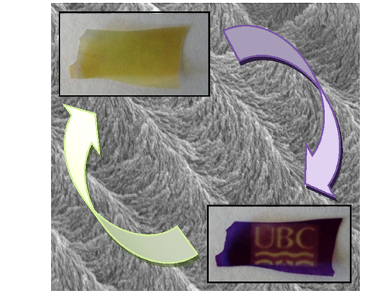Stimuli-responsive materials undergo reversible changes to external stimuli, e.g., light, heat, or electricity. This makes them attractive for applications such as optically rewritable data storage, smart windows, and sensors. Photochromic materials change color when exposed to light. Spiropyrans (SPs), for example, undergo reversible isomerization between the purple open merocyanine (MC) form and the colorless closed SP form when irradiated with ultraviolet-light or visible light, respectively.
Mark J. MacLachlan, University of British Columbia, Vancouver, BC, Canada, and colleagues functionalized chiral nematic mesoporous organosilica (CNMO) films, which have a helical porous structure, with photoresponsive SP molecules to create photopatterning freestanding films. Here, the mesoporosity and interconnected pore structure of the CNMO films allow for high loading of the SP molecules The new hybrid freestanding films show intense absorption signals and undergo reversible photoisomerization, switching from the colorless SP form to the purple MC form, when irradiated with ultraviolet-light.
The team further demonstrated that the large absorption band and high surface area of the hybrid films allow for sensitive detection of metals. Indeed, a reversible metal ion-binding center can be generated by the opened MC form through the negatively charged oxygen species. When a metal ion binds in the film, the absorption band shows a blue shift. As shown, the degree of blue shifting is determined by the metal species present.
- Photopatterning Freestanding Chiral Nematic Mesoporous Organosilica Films,
Andrea S. Terpstra, Wadood Y. Hamad, Mark J. MacLachlan,
Adv. Funct. Mater. 2017.
https://doi.org/10.1002/adfm.201703346



